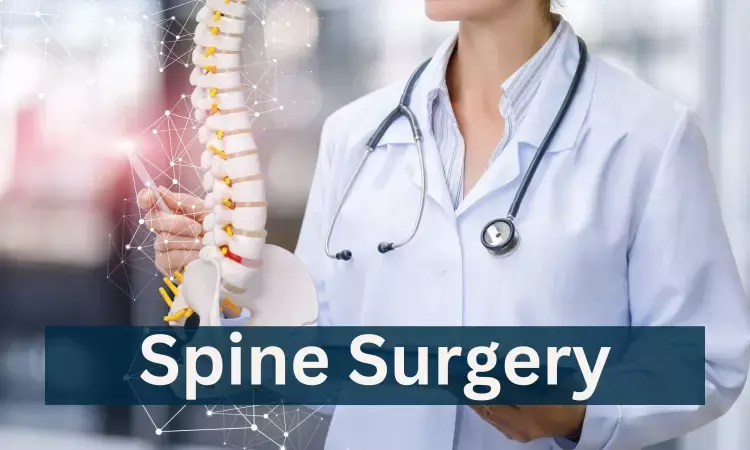- Home
- Medical news & Guidelines
- Anesthesiology
- Cardiology and CTVS
- Critical Care
- Dentistry
- Dermatology
- Diabetes and Endocrinology
- ENT
- Gastroenterology
- Medicine
- Nephrology
- Neurology
- Obstretics-Gynaecology
- Oncology
- Ophthalmology
- Orthopaedics
- Pediatrics-Neonatology
- Psychiatry
- Pulmonology
- Radiology
- Surgery
- Urology
- Laboratory Medicine
- Diet
- Nursing
- Paramedical
- Physiotherapy
- Health news
- Fact Check
- Bone Health Fact Check
- Brain Health Fact Check
- Cancer Related Fact Check
- Child Care Fact Check
- Dental and oral health fact check
- Diabetes and metabolic health fact check
- Diet and Nutrition Fact Check
- Eye and ENT Care Fact Check
- Fitness fact check
- Gut health fact check
- Heart health fact check
- Kidney health fact check
- Medical education fact check
- Men's health fact check
- Respiratory fact check
- Skin and hair care fact check
- Vaccine and Immunization fact check
- Women's health fact check
- AYUSH
- State News
- Andaman and Nicobar Islands
- Andhra Pradesh
- Arunachal Pradesh
- Assam
- Bihar
- Chandigarh
- Chattisgarh
- Dadra and Nagar Haveli
- Daman and Diu
- Delhi
- Goa
- Gujarat
- Haryana
- Himachal Pradesh
- Jammu & Kashmir
- Jharkhand
- Karnataka
- Kerala
- Ladakh
- Lakshadweep
- Madhya Pradesh
- Maharashtra
- Manipur
- Meghalaya
- Mizoram
- Nagaland
- Odisha
- Puducherry
- Punjab
- Rajasthan
- Sikkim
- Tamil Nadu
- Telangana
- Tripura
- Uttar Pradesh
- Uttrakhand
- West Bengal
- Medical Education
- Industry
ESP block tied to significantly lower opioid consumption in patients undergoing lumbar spine surgery, finds study

The current body of research does not definitively demonstrate whether the erector spinae plane (ESP) block or the thoracolumbar interfascial plane (TLIP) block is better at providing pain relief and reducing opioid consumption in lumbar spine surgeries. Recent systematic review and meta-analysis aimed to compare the efficacy and safety of ultrasound-guided erector spinae plane (ESP) block versus thoracolumbar interfascial plane (TLIP) block in patients undergoing lumbar spine surgeries. The primary outcome assessed was 24-hour opioid consumption, and secondary outcomes included visual analogue scale (VAS) scores at 1 and 24 hours and various complications such as nausea and vomiting, sedation, respiratory depression, and pruritus.
Findings of the Review
The review included six randomized controlled trials (RCTs) comprising 492 patients. The findings revealed that the ESP block demonstrated significantly lower 24-hour opioid consumption and lower VAS pain scores at 1 and 24 hours compared to the TLIP block. Importantly, no significant difference was noted in adverse events such as nausea and vomiting, sedation, respiratory depression, and pruritus between the two groups.
Trial Sequential Analysis
The review also conducted a trial sequential analysis (TSA) which suggested that additional studies are necessary to strengthen the findings. The primary objective was to explore the efficacy of the blocks in terms of 24-hour opioid consumption, with secondary objectives including VAS scores and safety profiles. The study followed the recommendations of the Preferred Reporting Items for Systematic Reviews and Meta-Analyses (PRISMA) statement for conducting and reporting the results.
Review Limitations
The ESP block was found to have a lower 24-hour opioid consumption and reduced VAS pain scores at 1 and 24 hours compared to the TLIP block. Despite the statistically significant findings, the review highlighted the need for caution due to limitations such as the small sample size and clinical heterogeneity across the included studies. The authors also stressed the importance of further research with larger sample sizes to strengthen the findings.
Conclusion
In conclusion, the meta-analysis found that the ESP block is superior to the TLIP block in terms of 24-hour opioid consumption and VAS pain scores at 1 and 24 hours in patients undergoing lumbar spine surgery. However, it emphasized the need for caution and further research to validate and strengthen these findings.
Overall Study Contribution
Overall, the study provided comprehensive insights into the relative efficacy and safety of the ESP block and TLIP block in lumbar spine surgeries, contributing valuable evidence to the field of anesthesia and pain management in orthopedic and spine surgeries.
Key Points
- Comparison of ultrasound-guided erector spinae plane (ESP) block versus thoracolumbar interfascial plane (TLIP) block in lumbar spine surgeries
- Primary outcome: 24-hour opioid consumption, secondary outcomes: VAS scores at 1 and 24 hours, and various complications - Findings from 6 randomized controlled trials (RCTs) with 492 patients
- ESP block resulted in significantly lower 24-hour opioid consumption and lower VAS pain scores at 1 and 24 hours compared to TLIP block
- No significant difference in adverse events between the two groups - Trial sequential analysis (TSA) suggested the need for additional studies to strengthen the findings, with emphasis on the small sample size and clinical heterogeneity as limitations
- Conclusion: ESP block is superior to TLIP block in terms of 24-hour opioid consumption and VAS pain scores at 1 and 24 hours, but caution and further research are emphasized to validate and strengthen the findings
- Overall study contribution: Offers valuable evidence for anesthesia and pain management in orthopedic and spine surgeries
Reference –
Majage S, Ravikumar RH, Prasanna M, Chandramouli M, Datta PK, Baidya DK. Comparison of efficacy of ultrasound‑guided erector spinae plane block versus thoracolumbar interfascial plane block in patients undergoing lumbar spine surgeries: A systematic review and trial sequential meta‑analysis. Indian J Anaesth 2024;68:752‑61
MBBS, MD (Anaesthesiology), FNB (Cardiac Anaesthesiology)
Dr Monish Raut is a practicing Cardiac Anesthesiologist. He completed his MBBS at Government Medical College, Nagpur, and pursued his MD in Anesthesiology at BJ Medical College, Pune. Further specializing in Cardiac Anesthesiology, Dr Raut earned his FNB in Cardiac Anesthesiology from Sir Ganga Ram Hospital, Delhi.


